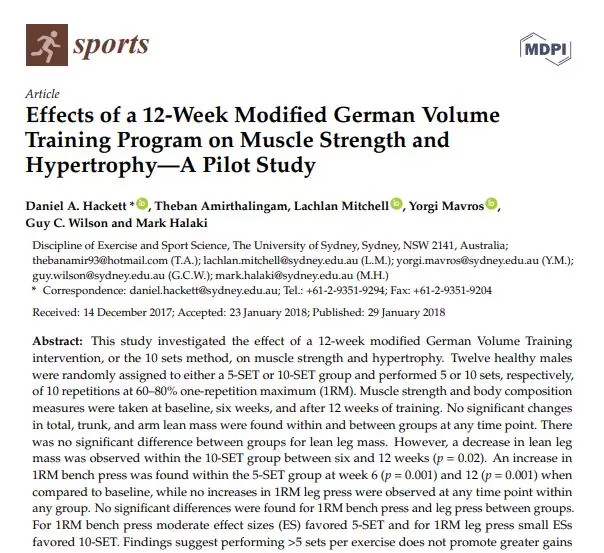‘Effects Of A 12-Week Modified German Volume Training’ PDF Quick download link is given at the bottom of this article. You can see the PDF demo, size of the PDF, page numbers, and direct download Free PDF of ‘The German Volume Training Plan To Build Muscle’ using the download button.
German Volume Training Workout Plan PDF Free Download

German Volume Training
Introduction
Resistance training is a physical activity that is commonly used to develop muscle strength and stimulate muscle hypertrophy.
Maximizing these training adaptations involves the appropriate manipulation of resistance training variables [1].
Arguably, one of the most critical variables influencing the effectiveness of resistance training on muscle strength and hypertrophy is volume [2].
Resistance training volume is defined as the total number of repetitions (repetitions x sets) together with the loads used for a given exercise.
However, previous studies examining the effect of resistance training volume on muscle adaptations have done so by controlling for factors that influence intensity (i.e., repetitions and load) and only manipulating the sets performed [3–7].
Based on current resistance training guidelines for muscle strength and hypertrophy, it is recommended that untrained individuals perform a lower number of sets per exercise compared to advanced trainers (1–3 sets compared to 3–6 sets, respectively) [8].
These guidelines suggest that as training experience increases, muscle strength and hypertrophy gains are optimized with an increased volume of up to six sets per exercise.
Three systematic reviews and meta-analyses have provided some interesting insights into the effects of set numbers on muscle strength and hypertrophy [2,9,10].
Krieger [9,10] found that 40% greater muscle strength and hypertrophy gains can be achieved with 2–3 sets compared to a single set per exercise.
Furthermore, Krieger [9,10] showed a dose-response relationship with greater muscle strength and hypertrophy gains with an increased number of sets, up to approximately 4–6 sets, where no further gains were observed.
These findings support the recommended set range for advanced trainers from the resistance training guidelines [8].
Also, Schoenfeld et al. [2] analyzed the impact of the total number of weekly sets per muscle group which was suggested to be a more relevant marker of training volume.
The results of this review and meta-analysis indicated a dose-response relationship between weekly resistance training volume and muscle mass, and it was concluded that at least 10 weekly sets per muscle group are necessary to maximize muscle mass.
It is well known that mechanical loading stimulates protein synthesis in skeletal muscle and lifting heavier loads will increase this response until a plateau occurs [11].
However, despite evidence for a plateau of muscle strength and hypertrophy gains beyond 4–6 sets [9,10], the upper threshold for a number of sets still remains unclear.
It has been suggested that a large resistance training volume (i.e., a greater set number) will induce extensive metabolic stress and mechanical tension that leads to greater substrate depletion, metabolite accumulation, and muscle damage [12].
With adequate post-training recovery, these factors will promote anabolic responses that lead to enhancing muscle mass [13] and possibly strength [14,15].
However, resistance training with volumes too far beyond an “upper threshold” will likely be counterproductive for strength-related tasks in general and may mute or debilitate the hypertrophic response [16].
German Volume Training (GVT) is a practice that has been used by national weightlifting coaches to increase the muscle mass of their athletes in the off-season [17].
A typical GVT session involves performing 10 sets of 10 repetitions (i.e., 100 repetitions) for two compound resistance exercises at loads of ~60% 1RM or 20RM [18].
Together with this high training volume, the recovery between sets is relatively short (~60–90 s) to induce greater metabolic stress (e.g., buildup of metabolites such as lactate).
We recently examined the effectiveness of a modified version of the GVT program (10 sets method) compared to the upper end of the set range commonly used by resistance trainers (five sets) over a duration of six weeks.
Briefly, the modification to the traditional GVT program included the performing of assistive exercises following the completion of two exercises performed for 10 sets.
Also, squats and deadlifts are traditionally used in GVT but were changed to leg presses and lunges.
The results from the previous study showed that no additional gains in muscle hypertrophy can be achieved when following a modified version of the GVT program compared to training with five sets over a duration of six weeks [19].
Another interesting finding from our previous study was greater increases in upper body strength for five sets compared to 10 sets, which is different from the few studies that have investigated the effects of a similar number of sets on muscle strength.
Drinkwater et al. [20] found no differences in bench press one-repetition maximum (1RM) following a six-week bench press training program comparing eight sets versus 12 sets. Likewise, Marshall et al.
[6] found no differences in squat 1RM when comparing four sets to eight sets following a six-week squat training program, although a significant increase in squat 1RM was observed for eight sets compared to one set.
However, due to the relatively short duration of our previous study (i.e., six weeks) [19] as well as the other studies noted above, it is unknown whether this may have affected the results. For instance, Stark et al.
[21] concluded that a resistance training protocol tailored for muscle strength and hypertrophy should be at least 10–12 weeks in duration involving 3–5 sessions per week.
Therefore, the effectiveness of a modified GVT program (i.e., 10 sets method) on muscle strength and hypertrophy when performed over a longer period of time is unknown.
| Author | – |
| Language | English |
| No. of Pages | 13 |
| PDF Size | 10 MB |
| Category | Health & Fitness |
| Source/Credits | researchgate.net |
German Volume Training Workout Plan Book PDF Free Download
